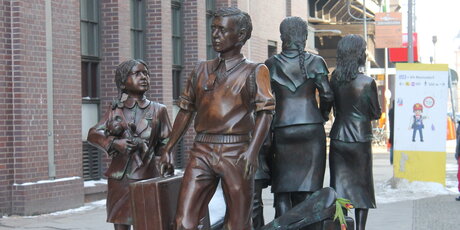Trains to Life – Trains to Death
Memorial to the Children's Transports during the Nazi Era
An almost life-size sculpture of children depicted in bronze stands directly adjacent to the Friedrichstraße station at the intersection of Georgenstraße and Friedrichstraße.
An almost life-size sculpture of children depicted in bronze stands directly adjacent to the Friedrichstraße station at the intersection of Georgenstraße and Friedrichstraße. Seven boys and girls represent the Jewish children of the 1930s. The arrangement of the group reflects the contrasting fate of the children in the Nazi era. Five figures in grey bronze look to one side, symbolising the suffering of those deported to concentration camps to meet an early demise. Two lighter bronze figures, however, gaze in the other direction. They represent those Jewish children whose lives were saved by the Kindertransport to England. More than two million children lost their lives from 1933 to 1945 through the tyranny of the Nazis.
London stockbroker Nicholas Winton, moved by the fate of Jewish refugees, worked with his fellow Britons to bring the first rescued children to the UK. These Kindertransporte were an attempt to protect the youngest victims of the Nazi dictatorship. These rescue missions allowed some 10,000 Jewish children from Germany, Austria, Poland and Czechoslovakia to escape deportation and find refuge in children's homes or with English families in London. The first train left Berlin's Friedrichstraße station with 196 children on board on 30 November 1938.
Today, a bronze sculpture by architect and sculptor Frank Meisler stands as a reminder of this place that meant freedom for many Jewish children. Meisler himself travelled with a 1939 children's transport from Berlin-Friedrichstraße to England.
